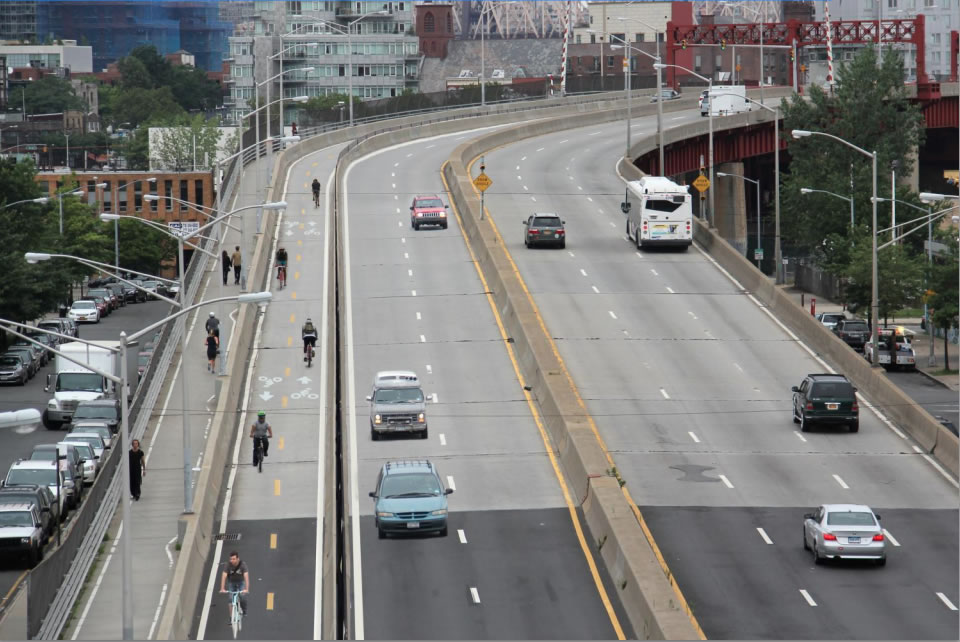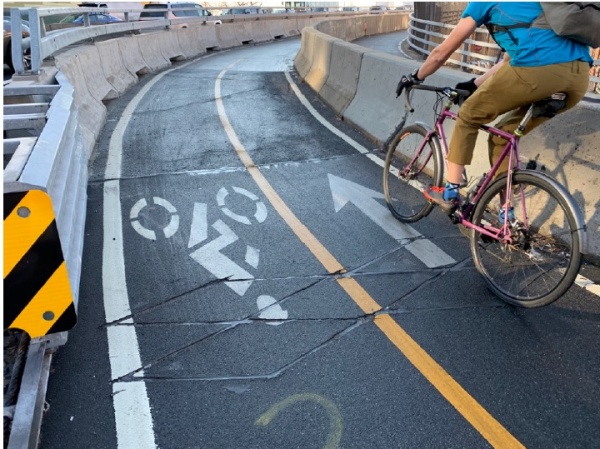
Pulaski Bridge on the Brooklyn Photo: DOT
Dec. 23, 2019 By Michael Dorgan
A bicycle advocacy group has released a study that argues the introduction of the protected bike pathway on the Pulaski Bridge has been a success—although more needs to be done to get cyclist numbers up.
The bridge’s two-way protected bikeway opened in 2016 to improve biking and walking access between Queens and Brooklyn. The 2016 change separated pedestrians and cyclists that had previously shared a congested pathway.
Bike New York, a not-for-profit bicycle advocacy organization, had hoped that bicyclist numbers would have increased much more than they have since 2016.
“We expected the increases to be more because it is such a good facility, although it is a little hard to get to on the Queens side” – Bike New York’s communications director Jon Orcutt said.
The organization did a recent bike count and observed 142 bikes per hour in peak commuting times and 53 bikes per hour in non-peak times in November. The organization counted bikes going in both directions.

Entrance to the Bridge on the Long Island City side (Bike NY)
In April 2013, the city counted an average of 99 bikes per hour—in both directions– over a 12 hour period when cyclists and pedestrians shared a path. Peak time data was not available for this story.
The months of the two counts–April and November–are not peak ridership periods since the weather is cool. The months of May through October are peak cycling periods.
The group, however, wants official DOT data which it claims hasn’t been released since the separate bicycle lanes opened in 2016.
The group has been calling on the DOT to release records from its official counters and make the information publicly available via open data sources.
A DOT spokesperson said that the agency is working on getting the data and that it will be made publicly available “within the next few weeks.”
Bike New York says that ridership on the bridge would be higher if there were “better bike network connections” in Greenpoint and especially in Long Island City, where the “Pulaski Bridge bike path opens into a very busy and complex set of street intersections.”
The study found that the majority of the cyclists crossing the bridge come from Brooklyn. During peak morning hours 80 percent of cyclists on the bridge were riding into Queens. In the evenings, 75 percent of cyclists were riding from Queens into Brooklyn.
 The study found that many bicycle riders from Brooklyn use the bridge to get into Manhattan.
The study found that many bicycle riders from Brooklyn use the bridge to get into Manhattan.
Some ride directly via the Queensboro Bridge while other riders use the bike lane to get to Long Island City subway stations including Vernon-Jackson subway station, where there is a significant amount of bike parking spots available.
However, the organization observed four times as many Citi Bikes used in peak versus off-peak hours which has led to a shortage of Citi Bike docks at Vernon-Jackson and Hunters Point Avenue subway stations in the mornings.
To help alleviate this problem, Bike New York, is calling for Citi Bike docks to be made larger at these stations.
The study also warned that there were some motorized vehicles using the bike pathway that were putting people at risk–and potentially putting bicyclists off using the lanes.
Bike New York said that 7.2 percent of bike lane users consisted of motorized users, most traveling at speeds consistent with bicycle traffic. However, there were a number of e-scooter, Revel and e-bike riders observed traveling at dangerously fast speeds.
Bike New York is urging city officials to monitor this trend to make sure the bike lane is safe.
Pulaski Bridge Bikeway Study November 2019 – Bike NY by Queens Post on Scribd





